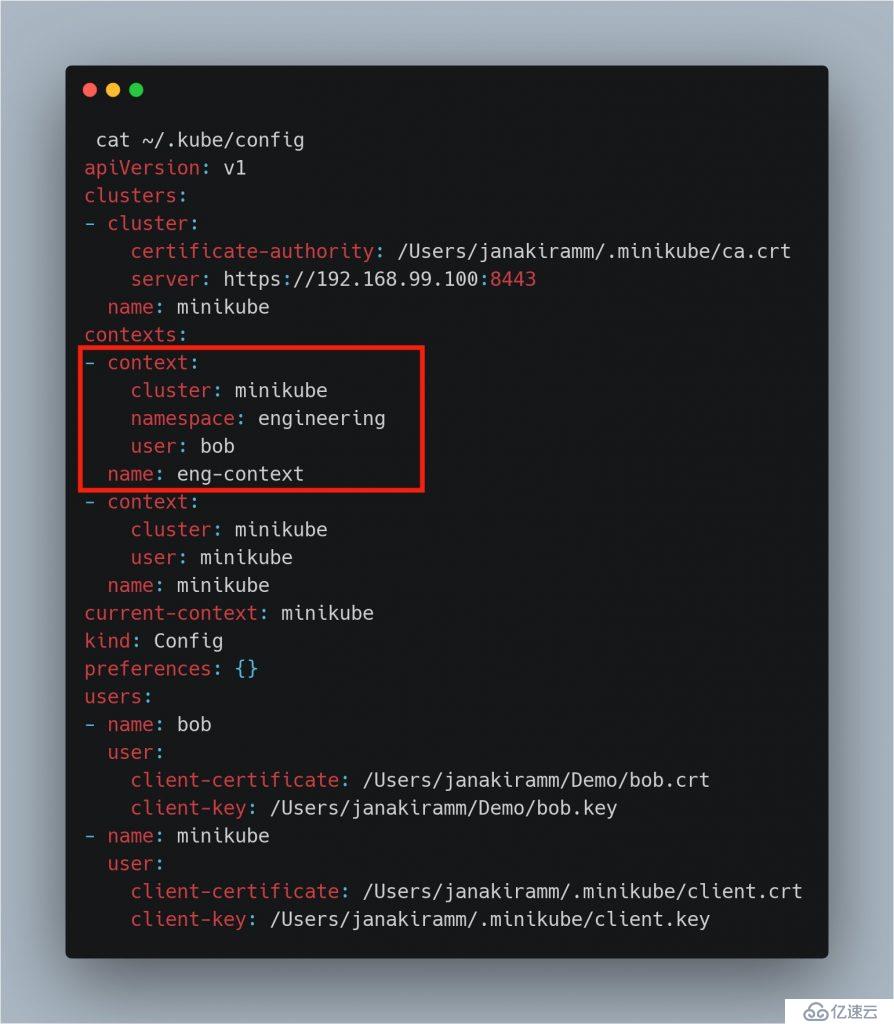您好,登錄后才能下訂單哦!
您好,登錄后才能下訂單哦!
這是本系列文章中的第三篇,前兩篇文章分別介紹了Kubernetes訪問控制以及身份認證。本文將通過上手實踐的方式,帶你理解Kubernetes授權這一概念。
?

?
在文章正式開始之前,我們先快速回顧一下我們實操過程中的環境和場景。我們正在處理生產環境中的集群,其中每個部分都與命名空間相關聯。現在,組里新來了一位同事叫Bob,我們在上篇教程中幫助Bob以engineering命名空間管理員的身份加入集群。并且他已經獲得私鑰以及簽名證書來訪問集群。
?
如果你還沒有完成上述操作,請查看上篇教程,運行其中的命令以完成環境設置以及為Bob配置證書。
?
好,我們正式開始本篇教程。
?
現在我們要給Bob授權,以控制屬于engineering命名空間的資源。
?
首先,我們要為kubectl創建一個上下文(context),方便它在不同的環境之間切換。
?
kubectl config set-context eng-context \
--cluster=minikube \
--namespace=engineering \
--user=bob
Context "eng-context" created.?
上面的命令使用Bob在minikube集群中的憑據創建了一個指向engineering命名空間的新上下文。這會導致在?/ .kube / config文件中添加一個新的部分。
?
?
我們現在在engineering命名空間中創建一個簡單的pod:
?
apiVersion: v1
kind: Pod
metadata:
name: myapp
namespace: engineering
labels:
app: myapp
spec:
containers:
- name: myapp
image: busybox
command: ["/bin/sh", "-ec", "while :; do echo '.'; sleep 5 ; done"]?
kubectl create -f myapp.yaml
pod/myapp created?
kubectl get pods -n=engineering
NAME READY STATUS RESTARTS AGE
myapp 1/1 Running 0 89s?
雖然您可以作為集群管理員在工程命名空間中創建和操作pod,但Bob甚至無法在同一名稱空間中列出pod。
?
kubectl get pods --namespace engineering --as bob
Error from server (Forbidden): pods is forbidden: User "bob" cannot list resource "pods" in API group?
為了使得Bob可以在engineering命名空間中訪問資源,我們需要給他授權。這可以通過創建具有適當權限的角色然后將其綁定到用戶Bob來完成。實質上,我們使用的是基于角色訪問控制(RBAC)來允許Bob對engineering命名空間中的某些Kubernetes資源執行特定操作。
?
創建一個名為eng-reader的Kubernetes角色,允許其在engineering命名空間中列出pod。
?
kind: Role
apiVersion: rbac.authorization.k8s.io/v1
metadata:
namespace: engineering
name: eng-reader
rules:
- apiGroups: [""] # "" indicates the core API group
resources: ["pods", "services", "nodes"]
verbs: ["get", "watch", "list"]?
kubectl create -f role.yaml
role.rbac.authorization.k8s.io/eng-reader created?
kubectl get roles --namespace=engineering
NAME AGE
eng-reader 58s?
注意,這一角色目前和Bob毫無關聯。我們需要通過角色綁定將角色中指定的權限應用于Bob。
?
kind: RoleBinding
apiVersion: rbac.authorization.k8s.io/v1
metadata:
name: eng-read-access
namespace: engineering
subjects:
- kind: User
name: bob # Name is case sensitive
apiGroup: rbac.authorization.k8s.io
roleRef:
kind: Role #this must be Role or ClusterRole
name: eng-reader # this must match the name of the Role or ClusterRole you wish to bind to
apiGroup: rbac.authorization.k8s.io?
kubectl create -f role-binding.yaml
rolebinding.rbac.authorization.k8s.io/eng-read-access created?
kubectl get rolebindings --namespace=engineering
NAME AGE
eng-read-access 31s?
讓我們來檢查一下Bob現在是否可以訪問pod。
?
kubectl get pods --namespace engineering --as bob
NAME READY STATUS RESTARTS AGE
myapp 1/1 Running 0 11m?
既然他現在已經關聯了eng-reader角色,那么他就獲得了pod列表的權限。
?
此時,Bob在集群中的訪問權限依舊十分有限。他所能做的只是在engineering 命名空間中列出pod。這對Bob幫助不大。他想要檢查集群中的節點數量,但是令他失望的是,他遇到了 forbidden error。
?
kubectl get nodes --as bob
Error from server (Forbidden): nodes is forbidden: User "bob" cannot list resource "nodes" in API group?
在Kubernetes中角色和角色綁定既可以應用在命名空間層面也可以應用在集群層面。我們現在創建一個集群角色以及一個與Bob關聯的角色綁定,以使他能夠列出節點。
?
kind: ClusterRole
apiVersion: rbac.authorization.k8s.io/v1
metadata:
# "namespace" omitted since ClusterRoles are not namespaced
name: cluster-node-reader
rules:
- apiGroups: [""]
resources: ["nodes"]
verbs: ["get", "watch", "list"]?
kubectl create -f cluster-role.yaml
clusterrole.rbac.authorization.k8s.io/cluster-node-reader created?
kubectl get clusterroles cluster-node-reader
NAME AGE
cluster-node-reader 49s?
kind: ClusterRoleBinding
apiVersion: rbac.authorization.k8s.io/v1
metadata:
name: read-cluster-nodes
subjects:
- kind: User
name: bob # Name is case sensitive
apiGroup: rbac.authorization.k8s.io
roleRef:
kind: ClusterRole
name: cluster-node-reader
apiGroup: rbac.authorization.k8s.io?
kubectl create -f cluster-role-binding.yaml
clusterrolebinding.rbac.authorization.k8s.io/read-cluster-nodes created?
kubectl get clusterrolebindings read-cluster-nodes
NAME AGE
read-cluster-nodes 35s?
現在,Bob已經設置為可以在集群中列出節點。
?
kubectl get nodes --as bob
NAME STATUS ROLES AGE VERSION
minikube Ready master 52m v1.15.2?
本篇教程的目的是為了幫助你理解角色以及角色綁定如何在Kubernetes中工作的。在本系列下一篇文章中,我們將來看看service account,保持關注喲~
免責聲明:本站發布的內容(圖片、視頻和文字)以原創、轉載和分享為主,文章觀點不代表本網站立場,如果涉及侵權請聯系站長郵箱:is@yisu.com進行舉報,并提供相關證據,一經查實,將立刻刪除涉嫌侵權內容。